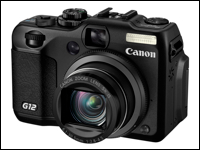All product photographs courtesy & copyright Canon.
As most of you know by now, Canon has introduced a new “G” series model, the PowerShot G12 to replace their flagship model the G11 as well as the highly successful G10. In the coming weeks there will be reviews galore posted on the various industry watching blogs with in depth discussions of this new model’s features and benefits. Folks that recently purchased the G11 will start to feel “buyers remorse” and “upgraders envy” over the perceived differences between their G11 and the new G12. The amount of forum traffic on DPReview.com will climb as folks begin to post their rants and raves about this new camera.
To help cut through some of the rhetoric I thought I’d post a quick and dirty comparison of the G10, G11 and G12 cameras based upon the information currently available. Right off the bat let me state that this comparison is from a still photographer’s perspective only. The video capabilities of both cameras are very cool but beyond my area of expertise.
G12 Features
High-sensitivity 10 Megapixel CCD
28mm wide, 5x zoom lens, Hybrid IS
HS System
7.0 cm (2.8″) Vari-Angle LCD, Electronic Level, OVF
ISO capabilities from 100-12,800, with expansion
Front Dial, Full Manual control & Multi-Control Dial
RAW shooting
HD movies, HDMI
High Dynamic Range mode
Smart Auto mode
Multi-Aspect Shooting
FA-DC58B lens filter adapter (Watch out Lensmate)
Sensor:
According to Canon, the G12 includes Canon’s new “HS” system – a combination of a high-sensitivity 10.0 Megapixel CCD sensor and powerful DIGIC 4 processing, which delivers exceptional low light performance. They claim it enables the camera to support a maximum ISO of 3200 at full resolution and works to reduce the occurrence of noise at all ISO speeds for high quality images. Users can also set their own parameters in Auto ISO mode, with the ability to limit the maximum ISO speed they want to employ during shooting.
ISO:
G10 – AUTO, High ISO Auto, 80, 100, 200, 400, 800, 1600
G11 – AUTO, 80, 100, 200, 400, 800, 1600, 3200
G12 – AUTO, 80, 100, 125, 160, 200, 250, 320, 400, 500, 640, 800, 1000, 1250, 1600, 2000, 2500, 3200
Pixels:
G10 – 14.7 MP
G11 – 10.0 MP
G12 – 10.0 MP
Image Stabilization
According to Canon, the G12 now uses their latest “Hybrid IS” system which corrects both angular (rotational movement) and shift shake (linear shake). The “Hybrid IS” system moves the lens elements to compensate for both types of movement – enhancing the effectiveness of the optical Image Stabilizer during macro shooting.
Processor: Same (DIGIC 4)
Lens: Same
Focusing: Same
Exposure Control: Same
Shutter: Same
White Balance: Same
Viewfinder: Same
LCD:
G10 – Fixed 3.0″ PureColor LCD II, 461,000 dots
G11 – Vari-angle 2.8″ PureColor LCD II, 461,000 dots
G12 – Vari-angle 2.8″ PureColor LCD II, 461,000 dot
Maximum Image Size:
G10 – 4416 x 3312
G11 – 3648 x 2736
G12 – 3648 x 2736
Interface:
G10 – A/V Out
G11 – HDMI, A/V Out
G12 – HDMI, A/V Out
Flash Sync:
G10 – 1/500th
G11 – 1/2000th
G12 – 1/2000th
Continuous Shooting:
G10 – 0.7 fps
G11 – 1.1 fps
G12 – 4.2 fps (Wow!)
Conclusions:
Honestly, it looks like there are really only four significant differences between the Powershot G12 and it’s predecessor the G11; the Hybrid IS system, the High Dynamic Range (HDR) mode, the ISO expansion capabilities and the 4.2 fps continuous shooting mode.
- If you plan to use the G12 as a travel camera, anything that provides a sharper hand-held image like Canon’s “Hybrid IS” is a huge plus in my book.
- Since I’m not into HDR photography, I’ll leave this new “in camera” HDR feature for others to comment on.
- I’m unimpressed with the ISO expansion capabilities in this camera. Pushing a penny-sized CCD sensor to ISO 3200 and above usually results in very noisy and grainy images. I’ll reserve judgment until I can test the G12 at ISO 1600 and 3200 but I’m not too hopeful.
- However, if Canon’s claim of 4.2 frames per second is correct, we’ve finally seen a P&S camera that can be used for action shots. This could be Canon’s “killer feature” and a significant reason to upgrade.
Some Final Thoughts:
I think the Powershot “G” series are superb cameras capable of delivering exception results under the right conditions. I do think that Canon has done the right thing in concentrating on improving the sensor in these cameras, rather than on just adding more megapixels with each new model.
I look at the G12 as an incremental release. Nothing earth shattering but some nice new features which build upon what’s available in the G11. I can’t see many G11 owners rushing out to buy a G12 but for folks looking at a high end P&S camera for the first time, its a great choice.
The real question is whether the G12 can beat the new Nikon Coolpix P7000 in image quality. I’m sure Nikon has had just about enough of folks buying a D3 or D700 as their “primary” camera and a Canon G10 or G11 as their “travel” camera.
But that’s a post for another time!



